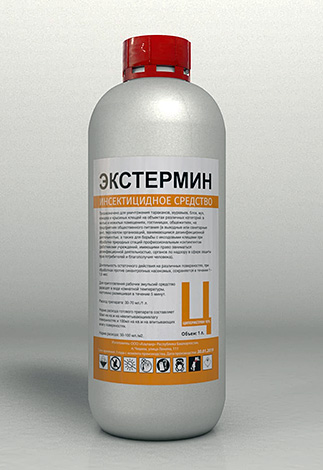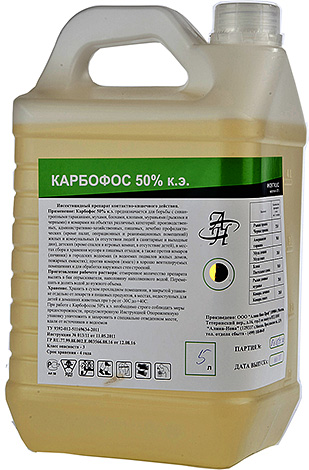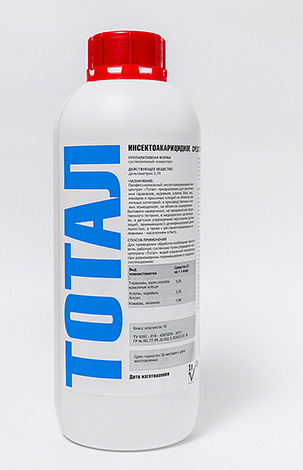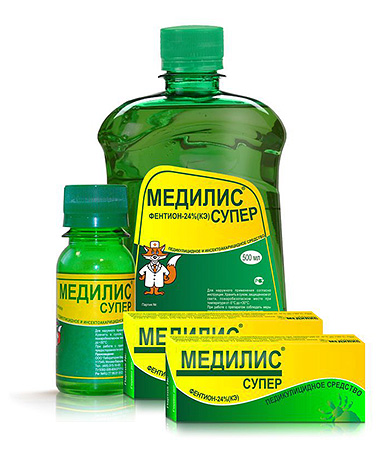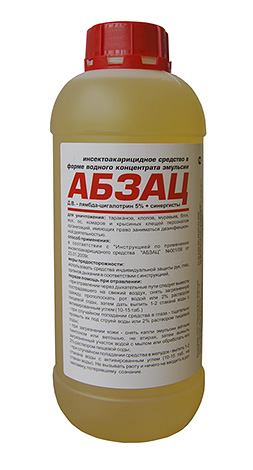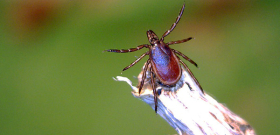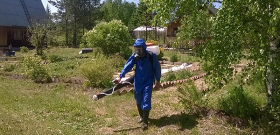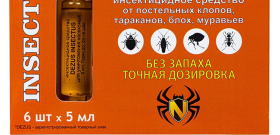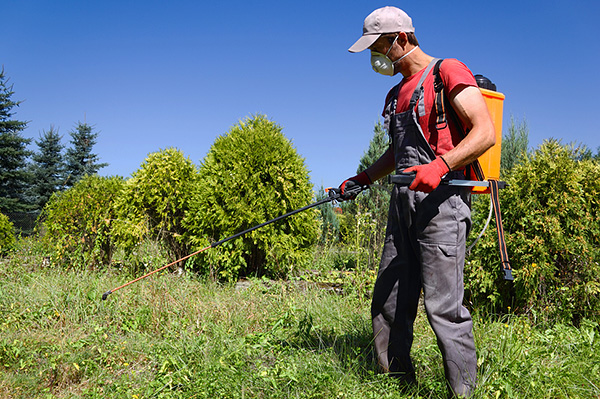
In order to independently treat the area from ticks and be sure that there will be no parasites here, at least until the end of the season, you don’t need so much: choose an effective remedy and properly spray the area with it. It depends on how strictly the basic rules of such acaricidal treatment are observed, whether people and pets will be able to calmly walk and relax in the local area or in the garden, without risking being bitten by vectors of tick-borne encephalitis and borreliosis.
It is important that the key rules for treating a site from ticks are the same for both professional and independent desacarization with the tools that are available in each subsidiary farm, and with those tools that can be bought in retail stores. At the same time, it is possible and necessary to use the experience and achievements of exterminators, who poison ticks almost every day during the season in a variety of areas - from lawns and vegetable gardens to large parks and fields.
Let's see what these rules are and what means allow you to carry out anti-tick treatment as efficiently as possible ...
How to choose a remedy for treating a site from ticks
Surprisingly, on the Internet you can often find the postulate that insecticides cannot be used to treat areas from ticks, since, they say, ticks are not insects (insecticides are insecticides), and only special acaricides should be used.

This is a misconception that only those “specialists” allow themselves who have never carried out anti-tick treatment in their lives, have not chosen a drug for it and do not understand the principles of action of such agents.
The fact is that almost all the most effective and common means for baiting insects are equally effective against ticks (arachnids). That is why they are often called insectoacaricidal. These include compounds of the pyrethroid group, organophosphates, carbamates, neonicotinoids, and some others. It does not matter which arthropod gets such a drug - a cockroach, a tick or a centipede - they all die at about the same speed.
Therefore, many products that are sold as insecticides are also well suited for baiting ticks. It is only important to look at the composition - as a rule, the most effective preparations for treating an area from ticks contain any of the following compounds as an active ingredient:
- Cypermethrin - very fast acting, preparations based on it are relatively inexpensive, most of them do not have a strong unpleasant odor. This is one of the most preferred acaricides for treating a garden plot or a lawn in a country house. Examples of drugs - Medilis-Ziper, Gardeks from ticks to protect the suburban area, Akaritoks, Extermin-C, Breeze;

- Karbofos (aka malathion) is highly effective, very inexpensive, well represented on the market, widely used for pest control in the garden and vegetable garden, and therefore is usually available in the dacha. Preparations based on it - Karbofos, Fufanon, Doublet;

- Deltamethrin is a substance of the same class as cypermethrin. Highly effective against mites, used in repellants and traps for mites. It is the active substance of the preparations Biorin and Total;

- Fenthion, an organophosphorus compound, has a rapid paralyzing effect and is often used to kill parasites that are resistant to other drugs. Examples of drugs - Executioner, Dobrokhim-Fos, Medilis-Super, Sulfox;

- Lambda-cyhalothrin, characterized by a particularly fast action and a wide spectrum of activity. Experienced exterminators report that preparations based on it literally "burn out" all living things where the solution hits the ground or grass. Therefore, by the way, you need to use such means very carefully so as not to massively destroy useful creatures - predatory beetles, bees, spiders. Examples of drugs based on lambda-cyhalothrin - Paragraph, Lambda-Zone and others.

Also, a large group consists of products containing several substances of different classes at once. For example, these are Acarocide based on cypermethrin and fenthion, Agran (chlorpyrifos and cypermethrin), Adamant (cypermethrin and malathion).
It is believed that their use is preferable to the use of monopreparations, however, this is not always true when treating a site for ticks. The fact is that products with several active ingredients are most in demand against insects, which are often poisoned in apartments and which can be resistant to one or another component.The likelihood of developing such resistance in ixodid ticks in the area is practically excluded due to their relatively small number here and the rarity of the treatments themselves.
It is interesting
Sometimes the owners of the plots are looking for the means by which forests were treated from ticks in the USSR. At the same time, it is somewhat naively believed that such drugs are much more effective than modern acaricides - after all, during the Soviet era, ticks were destroyed in the forests, and few people were bothered by them. Therefore, it is logical to assume that precisely due to the high efficiency of such treatments, neither ticks, nor tick-borne encephalitis or borreliosis were an actual problem. In fact this is not true. It's just that neither ticks nor tick-borne infections in the USSR were as widely known as they are today - due to the lesser availability of information and due to the fact that the connection of the infections themselves with ticks was established only in the 1960s. Plus, due to the smaller amount of transport, there were much fewer people spending time in nature than now, and therefore bites were less common.
The drug used to treat forests in the USSR and some other countries - the well-known DDT - turned out to be extremely dangerous, and the whole world agreed to stop its use. Modern insecticides based on pyrethroids and organophosphorus compounds are as effective as DDT, but much safer for humans and animals.
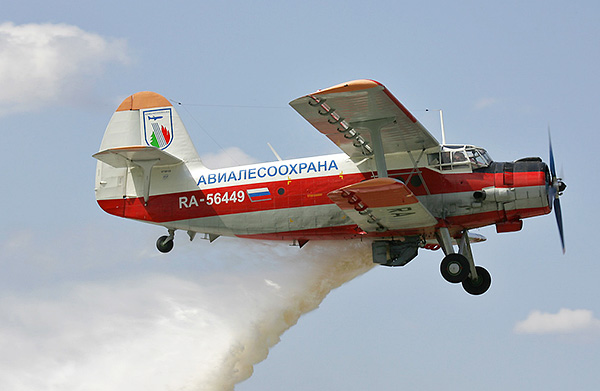
In general, for the treatment of small areas, lawns, flower beds and front gardens, it is advisable to use products available in small packages. In larger areas, you can use drugs that are easy to buy immediately in large packaging.
But it is usually impractical to buy ready-to-use products in cylinders or spray bottles: a liter of such a product can process 2-3 acres, and it costs the same as the concentrate for processing one hectare of territory.

On a note
Insecticides can be used to spray the area not only from ticks, but also from mosquitoes, garden ants, aphids, spider mites. However, in the case of such complex control, the biology of those arthropods that are supposed to be controlled must be taken into account. For example, to remove mosquitoes, it is necessary to destroy, first of all, their larvae in reservoirs and containers with stagnant water. To destroy ants, you need to find the entrances to the anthill and process them; from spider mites, you need to select such means that will not accumulate in fruits and berries.
Folk remedies for the destruction of ticks are ineffective. Attempts to eradicate parasites in a site without chemicals are almost always doomed to failure, since mites are resistant to many natural remedies, and methods for using home remedies are usually profanity and do not take into account the biology of parasites. So it’s better not to even try to poison the ticks on the site with a decoction of onion peel, a solution of soda or vinegar.
As a rule, folk remedies are trying to be used largely on the basis that their treatment will be safe for people and pets. It's a delusion. Due to the ineffectiveness of such products, ticks remain on the site after treatment, which continue to pose a serious danger to both people and their pets.The correct use of effective chemical acaricides is ultimately safer than the use of traditional methods of tick control.
How much drug you need to buy and how much it will cost
Most pest control products are sold in a concentrated form. As a rule, it is a liquid emulsion concentrate. To prepare a working solution from it, with which you need to spray the area, the product is diluted in the desired concentration with water.
The resulting solution is sprayed onto the ground, grass, various objects at a rate specified in the instructions for use of a particular product.
Some insecticides are sold in powder form:
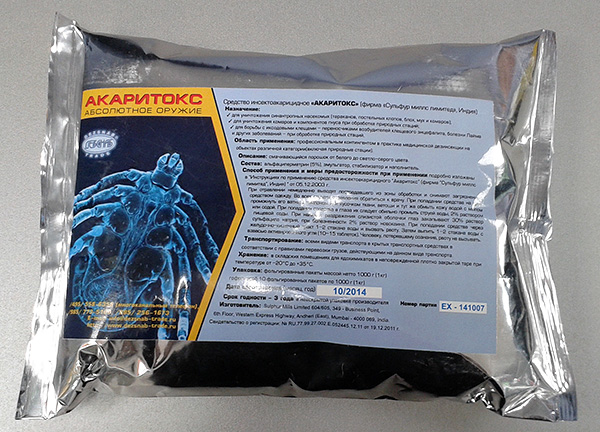
Before buying, you should calculate the required amount of the drug in order to purchase a suitable amount of funds.
Let's look at an example calculation:
- The concentration of the drug Acarocid when diluted is 10 ml per 1 liter of water. The consumption of the working solution when processing a summer cottage is 50 ml per 1 sq. m. Therefore, for each hundred square meters of land, 5 liters of working solution, or 50 ml of the initial concentrate, will be required. Acarocide is sold in bottles with a capacity of 1 liter - this is enough to treat a plot of 20 acres;
- Acaritox powder consumption - 10 g per 1 liter of water. The consumption of the working solution is 1 liter per 100 sq. m. Therefore, 1 kg of powder in a pack is enough to process 1 hectare of territory.
When making such calculations, it is always necessary to take into account the amount of the original product with a margin. The fact is that it is necessary to treat not only the lawn or garden from ticks, but also various decorative elements, borders, buildings, as well as areas outside the fence in order to create a buffer protection zone. All this will require an additional amount of funds - up to 20-25% of the volume, which is calculated simply by the area of \u200b\u200bthe site.
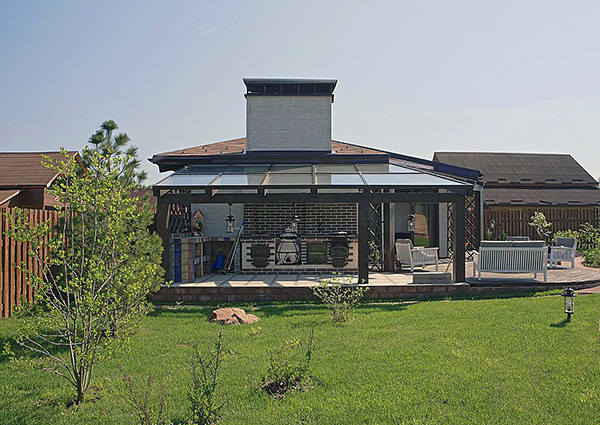
As a rule, the price of a drug for treating a plot of 6 acres is about 300-400 rubles, a plot of 10 acres - 500-600 rubles, and 20 acres - about 1000 rubles. For comparison, the price of professional processing of a plot of 10 acres is about 3,500 rubles.
Equipment used to treat the site from ticks
To treat the area from ticks, you can use almost any spraying device - from manual garden sprayers to special hot fog generators. The latter are used by specialists of disinfestation services for professional decontamination, since the generator allows you to process the site at high speed and more densely apply the agent to bushes, earth and grass.
At the same time, a hot fog generator is a rather expensive device, which is impractical to purchase once a year to treat the site.
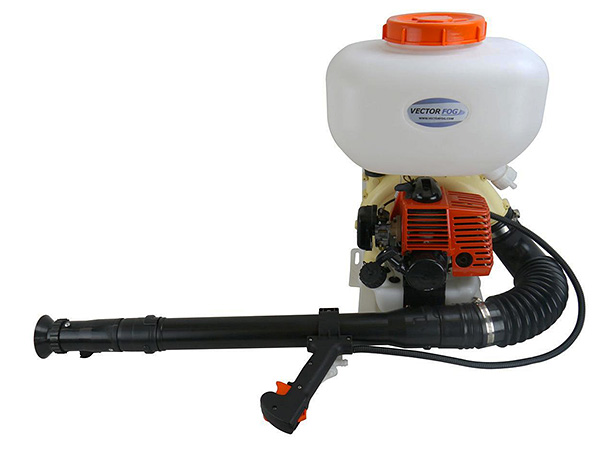
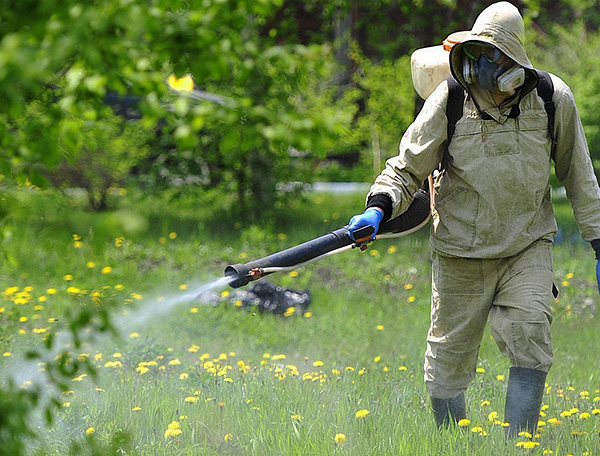
Therefore, for independent home baiting of ticks, you can use the same sprayer that treats trees and shrubs from pests. It will take longer to process the site with them, it will take about 15-20 minutes for each hundred square meters, but standard areas up to 20 acres can be completely cleared of ticks in one day.
The main requirement for an efficient sprayer is the formation of a jet, the diameter of which can be adjusted.Too directed spraying will not be convenient, as it will increase the consumption of the drug and processing time, but too “wide” jet in some places will not allow direct spraying, for example, cracks along the curbs.
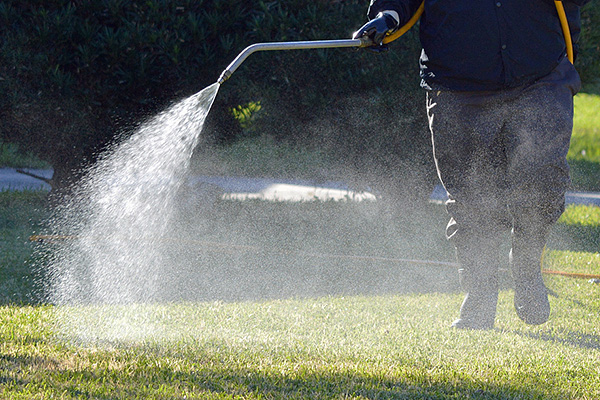
Standard pump sprayers used to treat trees and bushes are quite suitable for treating an area from ticks. Zhuk, Gardena, Frut devices with a tank volume of 5 liters can be considered optimal; handheld sprayers designed to be held in the hand are acceptable but much less convenient.
Preparing a treatment solution
The procedure for diluting a particular agent in water is usually described on the package, and the procedure does not present any difficulties. Here are just a few tips to follow:
- It is the drug that should be poured (or poured) into the water, and not vice versa;
- The selected volume of concentrate is best dissolved and used in portions. Often a situation arises when the calculated amount of the drug turns out to be excessive and part of the already prepared product remains unused. If you divide the entire product into 4-5 portions and cook them sequentially after processing part of the territory, the last portions can be reduced if necessary;
- If the instructions do not indicate a specific ratio of concentrate and water, but limits (for example, 100-150 ml per 1 liter of water), then it is preferable to use large amounts of the product. So the solution will be more effective;
- And dilute the drug, and pour it into the sprayer should be on the street, after putting on a respirator and gloves.

Unused mortar residues should not be poured simply on the ground, on a compost heap or in a summer toilet.In all these places, the product can kill decomposer invertebrates that play an important role in soil renewal and waste processing (for example, fly larvae and various beetles). To dispose of the remnants of the product, it is better to spray the area on the outside of the site boundary, along the perimeter.
Preparing the site for desacarization
Immediately before processing, the site should be carefully prepared for it. This will increase the efficiency of the procedure and allow more economical use of the product.
First, from the lawn, flower beds, lawns, recreation areas and from open soil, you need to remove all rubbish, garbage and unnecessary structures.
Secondly, it is desirable to mow the lawn before processing. The shorter the grass, the less working fluid will be required for its processing and the easier it will be to get this fluid to the soil on which ticks can be. The cut grass should be removed before spraying the lawn.
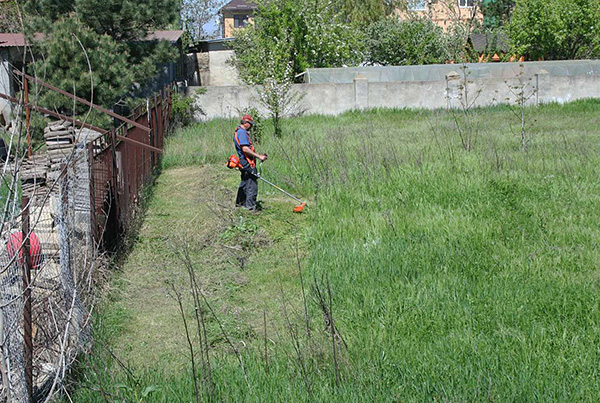
Similarly, from the lawn, and from flower beds, and from other places on the site where processing will be carried out, last year's fallen leaves must be removed. Right under them ticks hibernate, with foliage, part of the parasites can simply be thrown out, and the rest will be left without cover, and it will be better to poison them.
Thirdly, it is necessary to free the approaches to all buildings on the plot, to various large objects (benches, for example), to the fence, so that when spraying here, it is easy to apply the drug to the ground and grass.
Fourthly, you need to take out a doghouse to an open place.Ticks that fed on the pet can hide in and near it, and therefore the booth and the place under it must be treated with special care.
Finally, all the same must be done in the buffer zone - in a strip 5-10 meters wide from the border of the site. Here, too, there should be no garbage, rubbish, last year's fallen leaves and tall grass.

After that, be sure to check the weather forecast. It is necessary to process the site no earlier than two days after the last rain, but no later than two days before subsequent precipitation. Otherwise, there is a risk that the drug will be washed off the grass, and they will not be able to poison all the ticks.
On a note
Actually, it makes sense to dilute the product with water after checking the weather forecast. Manufacturers of some drugs do not recommend storing them after dilution for more than a day (they do not guarantee the effectiveness of the product when stored for more than one day after dilution with water).
We process the area from ticks correctly
When processing the territory, first of all, the places where grass grows are sprayed. Here the spraying must be continuous, so that the "stripes" or "spots" of soil and grass on which the product is applied must overlap with their edges.
Similarly, flower beds, low bushes, decorative elements (for example, potted plants or alpine slides) and borders are sprayed. The agent is applied to such objects up to a height of 40-50 cm. If the flowers in the flower bed are below this height, then they must be sprayed over the entire height.
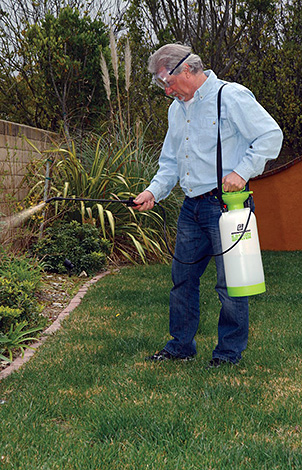
Various objects dug into the ground should be treated so that the drug penetrates into the cracks between them and the ground, since ticks hide in such cracks at night.
Be especially careful when spraying a dog house or dog kennel, as this is where most of the ticks in the area can be found. The booth should be sprayed both outside and inside - so that the product gets into all the cracks between the boards. On the place where the booth stood, or on the floor of the enclosure, you also need to apply the agent.
Similarly, the buffer zone behind the fence and the fence itself are sprayed on both sides to a height of up to 50 cm.
On a note
It is also advisable to take measures to prevent the entry of rodents into the site. In all technical buildings and in the basement of the house, mice, voles and rats should be regularly caught, in the ideal case, a cat should live on the site, which will protect the entire territory from rodents. It is mice and rats that bring ticks to the site (on their bodies), and it is these ticks, having fed and detached themselves on the site, that will leave their offspring here, which by the end of summer will begin bite people, cats and dogs.

Processing safety measures
When treating the site yourself, it is very important to follow safety measures to ensure that the acaricide applied does not harm the handler, other people on the site, or pets.
For this you need:
- Remove all people from the site for the duration of processing, except for the handler himself, and all pets;
- The handler needs to wear clothes with long sleeves and trousers that cover the legs to the ankles, gloves, a hat, goggles and a respirator (namely, a respirator designed at least for medical disinfection, but definitely not a simple gauze bandage from a pharmacy);
- It is necessary to dilute the product with gloves and a respirator;
- When processing, it is necessary to adjust the spray nozzle of the sprayer in such a way that the jet of the preparation is long enough, and the maximum amount of the agent would fall on the grass and the ground without rising into the air.
Pay attention to how the people professionally engaged in desacarization of sites are dressed (see photo below):
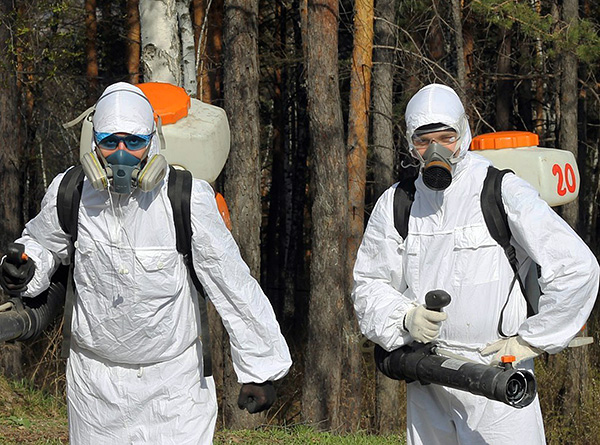
If during spraying the handler's health worsens and symptoms of poisoning appear - dizziness, nausea - you should immediately stop processing, go outside the treated area, remove the respirator and breathe, rinse your mouth and nose with water. If the condition does not improve, then you need to see a doctor.
When processing, it is important to ensure that the drug does not get on flowering trees and shrubs (here bees will die en masse from it), into the well, into bowls and drinking bowls for pets.
When you can go to the site without fear of being poisoned by the agent
In warm sunny weather, the drug dries on the grass in 3-4 hours. During this time, neither people nor pets should enter the treated area. Then you can go to the site and check if the product has dried. It is enough just to walk on the grass in shoes and see if it gets wet. If not wet, then people and animals can enter the site. From now on, you can lead your normal life here.

After drying, acaricidal preparations no longer pose a danger to humans, cats, or dogs. Moreover, when dew falls on the treated grass the next day, the product will still no longer be toxic to the inhabitants of the site.
On a note
Obviously, it makes no sense to treat ticks, for example, a clearing in the forest where a picnic is planned.Firstly, for such processing it will be necessary to mow all the grass in the clearing and treat it with a tool, which will require at least one full day of work. Secondly, you won’t be able to rest in this clearing on the same day. So for rest in the forest it is wiser to use simple personal protective equipment against ticks - repellents and special clothing.
Frequency of processing
Organizations, among other works conducting and acaricidal treatment of sites, poison ticks several times a year. In some areas, it is necessary to do 2-3 treatments during the warm season, in others it is enough to carry out one desacarization per year to be sure that there will be no ticks here.
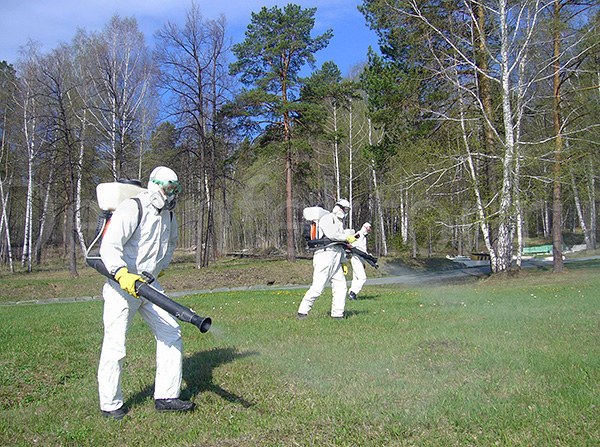
As a rule, spring processing is considered the main one. With the responsible approach of the owner of the site, it is carried out annually, regardless of whether ticks are found on the site or not. Judging by the reviews and statistics of the work of disinfestation services, with the regular conduct of such treatment once a year for 2-3 years, ticks are no longer found on the site at all. Each subsequent processing guarantees reliable protection of the territory from accidentally introduced parasites.
This spring treatment is carried out in April-May, depending on the latitude of the area, when the air temperature during the day already steadily exceeds 10 ° C, but fruit trees do not bloom yet.
If no treatments have been carried out on the site before, or if the site is located in a heavily infested area, and parasites can penetrate it in large quantities during the season, then several treatments should be carried out per season. In this case, the work schedule is as follows:
- The first treatment is carried out in April-May, with an increase in the average air temperature during the day to + 10 ° C;
- The second treatment is carried out 2 months after the first, usually in early July;
- The third treatment is carried out only for acarological indications, that is, when ticks are found on the site. This usually happens in late August - early September, during the period of mass hatching of tick larvae, or during the seasonal molting of nymphs and preparing them for leaving for the winter.
Usually two or three such treatments are needed in the first year only. In subsequent years, it is enough to spray the site only in the spring in order to destroy ticks that happen to be here and prevent them from breeding in the summer.
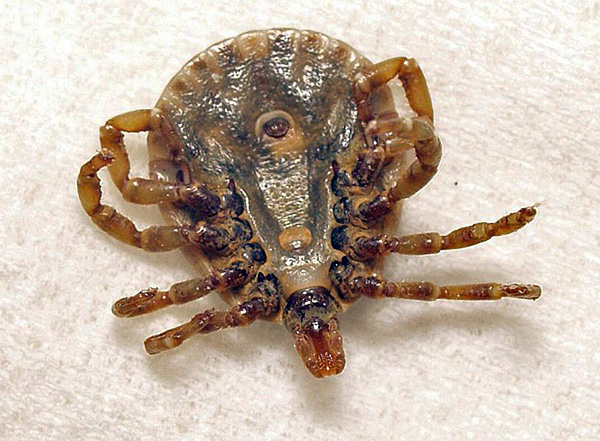
In difficult situations, more frequent decontamination work may be required. For example, land plots located in the forest or bordering directly on pastures of livestock, or vegetable gardens through which the routes of movement of wild animals lie, become infected with ticks very quickly - literally within two to three weeks after treatment. But it is not practical to process them on your own.
Usually, if this is a personal plot, then its owners sign an agreement with the pest control service for regular treatments, which reduces the price and makes such protection relatively budgetary. If this is a garden or vegetable garden that you don’t need to visit so often, it makes sense not to process them at all, and upon arrival here, simply take effective measures to protect against ticks.
Getting rid of ticks at their summer cottage: self-treatment of the site

